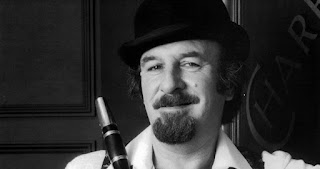It’s Trad, Dad
I think I am the only person in my circle of friends who
likes trad jazz. The others, especially the musicians and those with a serious
interest in music, tend to think of it as corny, cheesy, perhaps
over-simplified in terms of melodies.
George Orwell once wrote an essay on Kipling in which he
coined the phrase ‘good bad poetry’. He did not give a clear definition, but
the examples he gave, including much of Kipling’s work, Dowson’s Cynara (from
which we were bequeathed the phrase ‘gone with the wind’), and the Charge of
the Light Brigade, give you an idea of what he meant. Sentimentality, obvious themes,
an element of superficiality and a turn of phrase with which the reader can
identify are the attributes which his examples seem to have in common. He
described a good bad poem as ‘a graceful monument to the obvious’.
And something similar could be said of trad jazz. Catchy,
stick-in-your-ear melodies, lacking in subtlety, but nevertheless sometimes
evoking a mood which the listener recognises and with which he or she has
sympathy.
I seem to recall that we first got a record player round
about 1964 when I was eight years old. Along with this came a number of
records, several of which I am pretty sure my dad got for nothing (there were
some that if he did pay for them, he was done). A number of EP’s stick in the
mind.
Note to the younger generation. An EP in those days was a
seven-inch vinyl record played at 45 revolutions per minute which usually
contained four tracks. One such was by Pat Boone, including the ditties, The Main Attraction and Gondoli, Gondola (doan arsk, bleedin’
awful). Another was by Johnny Tillotson, including Poetry in Motion, Send me the
Pillow that you Dream On, … Anyway, for the most part they were murder.
One that I really liked, and for which to this day, hearing
the tunes strongly evokes my childhood, was by Kenny Ball and His Jazzmen. The
four tracks on this one were Midnight in
Moscow, The Green Leaves of Summer,
The March of the Siamese Children and
Sukiyaki. Have a listen to Sukiyaki.
https://www.youtube.com/watch?v=WeCAQmxq_Ew
Yes, it is corny, and the melody perhaps lacks subtlety, but
it at least has the charm of a calendar photograph, and for me at any rate a
haunting quality more profound than that. And I think that’s the link with
Orwell’s good bad poetry. You can see all sorts of things wrong with it, but it
still has something. One other thing to notice- the syncopation is spot on and
the professionalism of the playing impressive. You have to be just as skilled a
musician to play trad as to play be-bop, modal or avant garde jazz.
The very first entry in this blog, in January this year,
harked back to the swinging sixties and London as the then centre of the pop
culture world. What evokes that time and place most strongly for me, strangely,
is not a British piece at all, but something by an American trad outfit, The
Village Stompers. Their version of A
Taste of Honey is something of a curiosity. This ballad is given a very
bouncy, uptempo treatment, and consequently sounds rather ridiculous. But that
ill-fitting exuberance for me exemplifies the excitement and silliness of
swinging London in the 1960’s which I was too young (and several hundred miles
too far away) to experience.
https://www.youtube.com/watch?v=O2Nru6MBAGI
The Village Stompers were a New York outfit of the 50’s and
60’s, the Village being Greenwich Village, as you might imagine. Let me play
you one more track by them, which for me is the perfect trad number, Washington Square. The arrangement here
is so impressive, starting with just the banjo, with the rhythm section
gradually joining, and then a couple of minutes in, the brass comes in, in full
Dixieland style. Also, the monochrome photos on the YouTube video are terrific.
I particularly like the Manchester train in the middle.
https://www.youtube.com/watch?v=tUAwqhnqSAc
******************************
Let me finish with a couple of jazz-related stories. On one
of his live albums, introducing The Be-Bop Tango of the Old Jazzmen’s Church, Frank
Zappa remarks to the audience: ‘Ladies and gentlemen. Jazz is not dead. It just
smells funny.’
The second story is of a children’s television programme from
the 1970’s, about the mechanics of music. I seem to recall that it was hosted
by the late Roy Castle. One week, the theme was instruments which you have to
blow. There were three guests, a rather hippyish lady who played flute in a
classical orchestra, a military bugler, and the trad jazz bandleader and clarinettist,
Acker Bilk. One question Roy Castle asked all three was: when do you practise?
The flute player said that although she participated in group orchestral
rehearsals, individually she only practised when she felt like it (she was
rather hippyish, as I say). The soldier who played the bugle said in clipped
military tones, ‘Five pm to seven pm every weekday.’ Acker Bilk, in his lovely
West Country accent, said, ‘I’m gigging six nights a week. When would I practise?’




Comments
Post a Comment